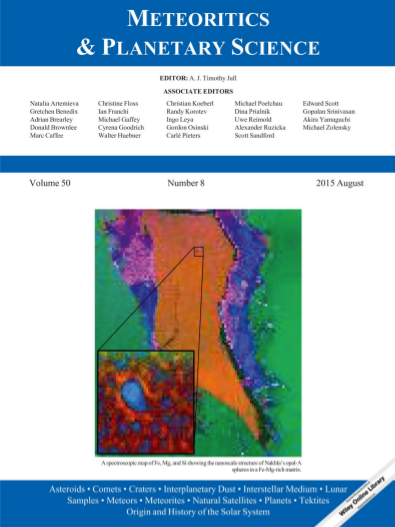Glasgow research featured on the front cover of "Meteoritics and Planetary Sciences"
Published: 19 August 2015
New research by a team including Dr Ian MacLaren of the School of Physics and Astronomy has revealed unprecedented detail about water interacting with rocks on the surface of Mars...
 New research on weathering of Martian rocks by water several hundred million years ago has been featured on the front cover of Meteoritics and Planetary Sciences. The study concentrated on a Martian meteorite, Nakhla, and specifically on the structure of the mineral (iddingsite) formed by the intrusion of water into cracks in the rock. The work used scanning transmission electron microscopy to show the nanoscale details of the weathering of the iron- and magnesium-rich olivine from a pre-existing lava flow, and it was shown that the iddingsite is actually an extremely fine opal-A structure of nanosized silica globules in a hydrated Fe-Mg rich matrix. This work settles years of speculation as to the exact identity of iddingsite. Furthermore, this work helps to further understand the climate history of Mars at a time when its surface was much wetter than it is now.
New research on weathering of Martian rocks by water several hundred million years ago has been featured on the front cover of Meteoritics and Planetary Sciences. The study concentrated on a Martian meteorite, Nakhla, and specifically on the structure of the mineral (iddingsite) formed by the intrusion of water into cracks in the rock. The work used scanning transmission electron microscopy to show the nanoscale details of the weathering of the iron- and magnesium-rich olivine from a pre-existing lava flow, and it was shown that the iddingsite is actually an extremely fine opal-A structure of nanosized silica globules in a hydrated Fe-Mg rich matrix. This work settles years of speculation as to the exact identity of iddingsite. Furthermore, this work helps to further understand the climate history of Mars at a time when its surface was much wetter than it is now.
This work was a collaboration between a team led by Prof. Martin R. Lee in Geographical and Earth Sciences and Dr Ian MacLaren in Physics and Astronomy (including important contributions from one of our undergraduate students, Ms Sia Andersson, in a summer project), with the meteorite sample kindly provided by Dr Caroline Smith at the Natural History Museum, and collaborators at the Scottish Universities Environmental Research Centre and Forschungszentrum Jülich (Germany).
The full article can be found at the following link.
First published: 19 August 2015
<< 2015 Archive

